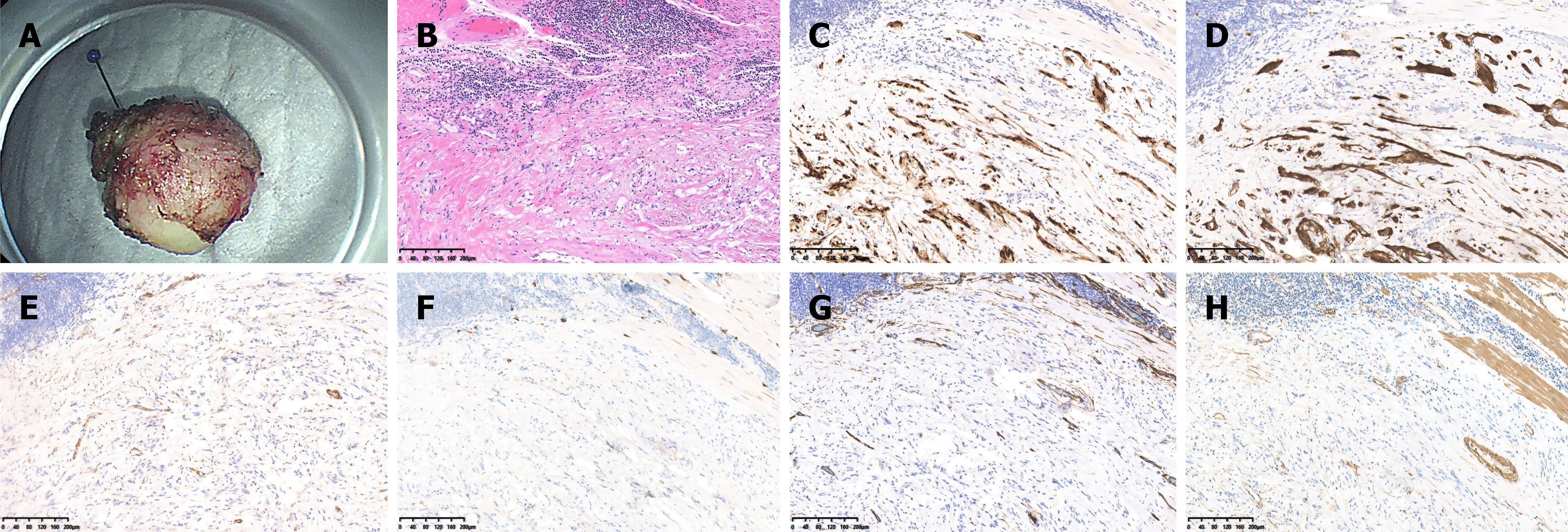Copyright
©The Author(s) 2025.
World J Gastroenterol. Feb 7, 2025; 31(5): 101280
Published online Feb 7, 2025. doi: 10.3748/wjg.v31.i5.101280
Published online Feb 7, 2025. doi: 10.3748/wjg.v31.i5.101280
Figure 1 Abdominal enhanced computed tomography reveals mild to moderate enhancement of the schwannomas during the arterial phase, with enlarged lymph nodes visible around oval-shaped tumors.
A: Tumor located in the greater curvature of the gastric body; B: Tumor observed in the gastric sinus; C: Tumor also located in the greater curvature of the gastric body; D: Tumor identified in the ileocecal region.
Figure 2 Endoscopic images depicting submucosal mass of gastrointestinal tract schwannomas.
A: Hemispherical tumor from the middle section of the esophagus; B: Discoid tumor with central depression from the upper curvature of the gastric body; C: Spherical tumor from the sigmoid colon; D: Wide-based spherical tumor with superficial erosion from the lower curvature of the gastric body.
Figure 3 Endoscopic ultrasonography images showing hypoechoic submucosal masses of gastrointestinal tract schwannomas originating from the muscularis propria.
A: Tumor with uniform echoes from the muscularis propria of the esophagus; B: Tumor with uneven echoes from the muscularis propria of the gastric body; C: Tumor with uniform echoes from the muscularis propria of the sigmoid colon; D: Tumor with uniform echoes from the muscularis propria of the gastric body.
Figure 4 Gross and pathological findings of esophageal schwannoma resection via submucosal tunnel endoscopic resection (from the first patient shown in the previous endoscopic images).
A: Endoscopic imaging showing a solid tumor measuring 1.4 cm × 1.2 cm × 0.8 cm; B: Pathological examination revealing that the tumor was composed of bland spindle cells (hematoxylin and eosin, 100 ×) with chronic inflammatory cell infiltration around the tumor; C and D: Positive immunohistochemical staining of SOX-10 and S-100 (magnification, 100 ×); E-G: Negative immunohistochemical staining of DOG-1, CD-117, and CD34 (magnification, 100 ×); H: Slightly positive immunohistochemical staining for SMA.
Figure 5 Gastrointestinal schwannomas.
A: Tumor diameter distributions of gastrointestinal schwannomas; B: Annual incidence trends of gastrointestinal schwannomas between 2007 and 2023.
- Citation: Zhang PC, Wang SH, Li J, Wang JJ, Chen HT, Li AQ. Clinicopathological features and treatment of gastrointestinal schwannomas. World J Gastroenterol 2025; 31(5): 101280
- URL: https://www.wjgnet.com/1007-9327/full/v31/i5/101280.htm
- DOI: https://dx.doi.org/10.3748/wjg.v31.i5.101280













